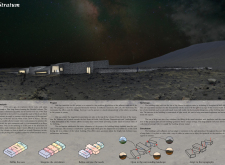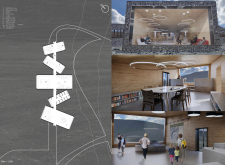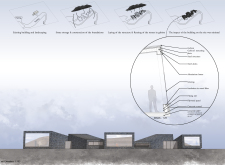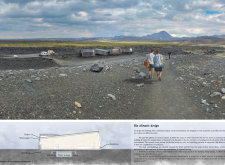5 key facts about this project
The design encompasses various spaces, including a café, a showroom, exhibition areas, and office facilities. Each of these functions is intentionally separated yet interconnected, reflecting an adaptive design approach that accommodates diverse activities and allows for flexibility in usage. This multipurpose nature of the building underscores its role as a vibrant community hub, fostering connectivity among visitors and encouraging interaction within its distinct areas.
Material choice plays a significant role in the overall architectural expression of Stratum. The use of gabion walls, constructed from locally sourced stone, provides not only structural integrity but also an aesthetic quality that resonates with the surrounding landscape. These walls symbolize connection to the earth, bridging human activity with geological history. Inside, warm, light timber is employed to provide an inviting atmosphere, contrasted with the robust exterior. This choice of materials promotes natural warmth and comfort for occupants and guests alike.
The structural framework consists of steel, offering substantial support while allowing for expansive interiors and open layouts. This strategic use of material contributes to the project's focus on sustainability as well, further exemplified by its energy-efficient features. The building is designed to harness natural light effectively through large glazing sections, reducing reliance on artificial lighting and enhancing occupant experience by fostering a connection with the exterior environment. Additionally, the integration of rainwater harvesting mechanisms showcases a commitment to resource management and ecological responsibility.
Spatial organization is key in the design of Stratum. Thoughtfully designed circulation routes facilitate seamless transitions between different functional areas, enhancing user experience while maintaining a sense of connectivity to the outside views. Large bay windows are positioned to frame scenic vistas of Hverfjall, encouraging occupants to engage visually with the extraordinary landscape outside, which cultivates an appreciation of the natural surroundings.
Stratum’s adaptability to seasonal usage is another hallmark of its design. The building is equipped to handle varying public attendance throughout the year, ensuring its relevance and utility in diverse circumstances. This characteristic further supports its role as a community gathering place, offering spaces that can be used for a range of activities, from exhibitions to casual meetings.
Unique elements of this architectural design lie in its integration with the volcanic landscape and its emphasis on sustainability and community interaction. The project maintains a respectful dialogue with nature while providing functional spaces that meet modern needs. By embracing local materials and leveraging sustainable practices, Stratum stands as a model for future projects that seek to blend architecture with environmental consideration.
This analysis reveals a comprehensive understanding of the practical and aesthetic dimensions of the Stratum project. For those interested in a deeper exploration of the architectural ideas shaping this design, including detailed architectural plans and sections, further investigation into the project presentation is encouraged. This can provide valuable insights into the innovative approaches taken in crafting spaces that not only serve their purpose but also resonate with the ecological context in which they exist.


























